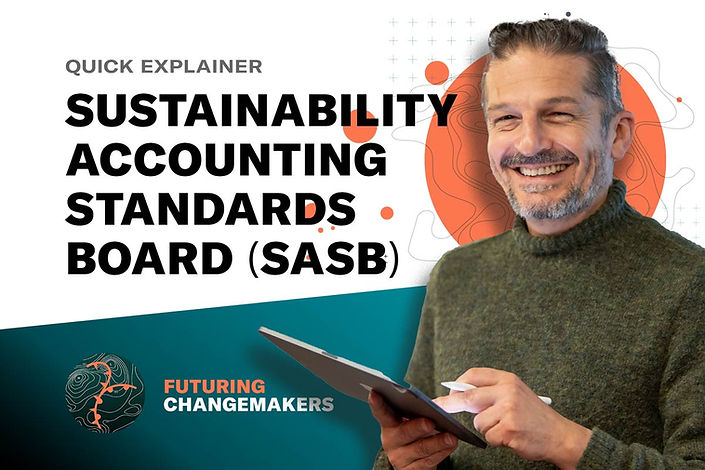Quick Explainer: How the Sustainability Accounting Standards Board (SASB) Drives Industry-Specific ESG Reporting for Financial Success
- Admin

- Oct 24, 2024
- 4 min read
Updated: Oct 25, 2024

Definition:
The Sustainability Accounting Standards Board (SASB) is a global standard for sustainability reporting that helps companies disclose industry-specific, financially relevant ESG data (Environmental, Social, Governance). Unlike other frameworks like GRI, which focus on the general impacts of a company on the environment and society, the SASB standards emphasize financial materiality, helping companies identify and report on ESG topics that directly affect their financial performance. This clear focus allows investors to make more informed decisions. Website SASB
Mental Shortcut:
Think of SASB as a financial navigation system that helps companies clearly identify the financially relevant sustainability risks and opportunities, delivering the crucial data directly to investors.
Application:
SASB standards are used globally across various industries to identify ESG risks and opportunities that impact financial performance. They have proven particularly effective in sectors such as energy, technology, and manufacturing, where clarity and consistency in reporting are essential.
Real World Examples:
Vestas Wind Systems (Denmark): Vestas uses SASB standards to comprehensively report on sustainable production and environmental measures, leading to improved transparency and greater investor trust
Research Using SASB Standards, Integrating SASB Standards Into a Dynamic ESG Composite Score
Howdens Joinery (UK): By applying SASB standards, Howdens reports on energy-efficient manufacturing processes and CO2 reductions. This clear reporting has helped the company improve efficiency and achieve better ESG ratings
Novozymes (Denmark): Novozymes leverages SASB to present its innovations in biotechnology and sustainability, gaining a competitive advantage and stronger market positioning
Integrating SASB Standards Into a Dynamic ESG Composite Score
ESG Integration Insights – 2020 Edition
Benefits:
Clarity and Consistency: SASB standards enable targeted reporting on financially relevant ESG topics, allowing companies to deliver precise and comparable data. This saves resources and enhances value for investors.
Improved Investor Relations: Standardized and transparent reports build investor trust, enabling companies to clearly communicate key ESG risks and opportunities. Integrating SASB Standards Into a Dynamic ESG Composite Score
Integration with Global Standards: The connection to IFRS S1 and S2 allows companies to seamlessly adapt to international requirements, providing a competitive edge for future regulations.
Cost and Resource Efficiency: Companies can streamline their reporting by focusing on a few but essential ESG metrics that carry real financial relevance. Why companies use SASB Standards
Challenges:
Resource Intensity: Implementing SASB standards can be costly and time-consuming, especially for smaller companies, due to the demands of data collection and verification.
Overcoming Implementation Challenges at Small- and Mid-Size Companies, An Eight-Step Guide to the SASB Standards Disclosure Process
Data Availability: It can be challenging to gather consistent and accurate ESG data, which affects the comparability and transparency of reports.
Wolters Kluwer Expert Solutions, A Conversation on Implementing SASB Standards with Sara Neff of Kilroy Realty
Integration Complexity: Combining ESG and financial reports poses a challenge, as different structures and metrics need to be harmonized.
What Not to Do:
Neglecting Materiality Analysis: Avoid reporting without thoroughly assessing which ESG topics are material to your industry. This leads to inefficient reporting and reduced credibility
Inconsistent Data: Reporting inaccurate or incomplete data undermines transparency. A robust system for data validation is essential
Separating ESG and Financial Reporting: ESG topics should not be viewed in isolation. Integrating them into financial reports strengthens the overall performance narrative
How to Start with SASB:
Conduct Materiality Analysis: Use tools like the SASB Materiality Finder to identify industry-specific ESG topics.
Implement Gradually: Start with key topics and expand your reporting over time.
Foster Internal Training and Collaboration: Teams need to understand the significance of the standards to report effectively.
Leverage ESG Software: Platforms like Bloomberg Terminal ESG Analysis can streamline data collection and reporting.
Perspectives & Case Studies, Conservice ESG
Framework & Tools:
SASB Materiality Finder: Helps companies efficiently identify industry-specific ESG risks and select relevant topics.
XBRL Taxonomy: Supports structured reporting and facilitates the integration of ESG data into financial reports.
IFRS S1 and S2 Standards: Global standards based on SASB that promote unified ESG reporting.
ESG Software like Bloomberg Terminal and FactSet: Simplify data collection, analysis, and ESG performance benchmarking.
SASB Related Topics:
ESG strategy, GRI standards, sustainability reporting, financial materiality, circular economy, IFRS S1 and S2, TCFD, corporate social responsibility, corporate governance, resource efficiency, sustainable business practices, climate-related risks, investor relations, industry-specific disclosure, data consistency, regulatory compliance, sustainability risks, stakeholder engagement.
Source and References:
SASB Standards Explained | AMCS Group - Overview of the importance and application of SASB standards across various industries.
Integrating SASB Standards Into a Dynamic ESG Composite Score | FactSet - Use of SASB: Research Using SASB Standards, Investor strategies and improved ESG analysis
Navigating SASB: A close look at the Sustainability Accounting Standards - Detailed explanations and practical applications of SASB standards. Link
ESG Integration Insights | SASB - Case studies
SASB of how leading companies and investors integrate SASB standards. Link
Bloomberg Terminal ESG Analysis - Platform supporting ESG reporting that integrates SASB data. https://www.bloomberg.com/professional/products/indices/esg-climate/
Publications & Studies:
Khan, Mozaffar, Serafeim, George, Yoon, Aaron (2015) Corporate Sustainability: First Evidence on Materiality. Harvard Business School. This study shows that companies focusing on financially material sustainability aspects tend to perform better financially. Study
Busco, Cristiano, Consolandi, Costanza Robert G. (Eds.) (2020) A Preliminary Analysis of SASB Reporting: Disclosure Topics, Financial Relevance, and the Financial Intensity of ESG Materiality. This analysis examines the effectiveness of SASB standards and their practical application. Study

Comments